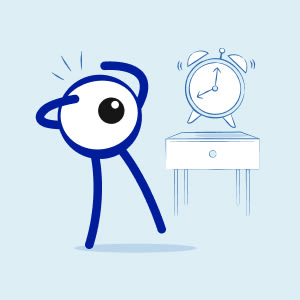How long does it take to get used to contacts?
Typically, it takes anywhere from a few days to about 2 weeks to get used to contacts. During that adjustment window, you may notice mild dryness or feel like you’re living inside a Monet painting — with everything in soft focus. These quirks should fade as your eyes adapt.
But if you experience persistent pain, alarmingly red eyes, or a haze that never lifts, call your eye care professional stat. You want crystal-clear vision, not to be living in an unintentional impressionist masterpiece. Read on to learn how long it takes to get used to contacts.
How to get used to contacts
You’ve got your prescription, a shiny new box of lenses, and big dreams of vision so clear you can spot your cat’s shenanigans from across the room. Let’s make it happen!
And what if your eyes are extra special? Maybe you have a monovision prescription, multifocal lenses, or astigmatism-correcting contacts. Below, we tell you how to adjust to contacts — including the extra-special ones — and how long the adjustment might take.
Before you put them in
Before putting your new contacts in:
-
Wash your hands like you’re going into surgery: Use soap, warm water, and a full 20-second scrub. Your eyes don't need random germs tagging along.
-
Check the packaging: Make sure the lens blister is sealed and the solution is clear. If something looks off (torn foil, crusty lens), toss it.
-
Confirm orientation: If your lens has a “123” mark, make sure it’s right-side up (like a mini bowl, not a saucer).
-
Have a clean space: Dropping a brand-new lens on a dusty counter is a fast path to frustration (and an itchy eye).
After you put them in
When you take them out:
-
Wait a hot second: A slight foreign object sensation at first is normal — your eyelids are hosting a new guest. Give yourself a few minutes to relax after putting your contacts in. This will give you time to get acclimated to how the lenses feel in your eyes.

-
Notice any redness or stinging: Mild dryness? Push forward. Real pain? Hard pass — take them out and see your eye care professional if it continues.
-
Keep track of time: If this is your first time wearing contacts, start off with a few hours and add more time each day. Set alarms to remind you to remove and clean your lenses. Once you've adjusted to how contacts feel in your eyes, it can be hard to remember to take them out and clean them as needed.

If you’d like a more thorough guide on exactly how to pop those lenses onto your corneas, visit our article on how to put in contacts because down-the-sink situations are heartbreakers.
How long should you wear contacts for the first time?
Take a break from contacts if you need to. Don’t force yourself to continue wearing them if your eyes are irritated or need a little R & R. A good rule of thumb when it comes to how long to wear contacts for the first time is 3-4 hours on the first day. If things feel good, add an hour or 2 each day. The idea is to let your eyes adjust without turning them into overworked employees on day 1 of a new job.

Adjusting to monovision contacts
Ready to unleash your inner superhero? Monovision is like having special powers in each eye — one for near, one for far, and you get to merge them into one glorious view. Monovision contacts are often prescribed for presbyopia (affectionately known as "old eye'" and famous for making people hold restaurant menus at arm's length). One lens corrects distance, and the other lens helps with up-close tasks.
Tips to make it work:
-
Practice switching focus: Look at your phone, and glance across the room or out the window.
-
Give it 2 weeks: Your brain is basically learning a new language. Some pick it up quickly; others need a bit more time.
-
Don’t sweat a little depth-perception wonkiness: Parking your car might feel more challenging for a few days but just take your time and be careful.
-
Plan a test drive: If you’re anxious about depth perception, practice driving in an empty lot or quiet street before diving into rush-hour traffic.
How long does it take to get used to monovision contacts?
Most people adapt to monovision contacts in about 1-2 weeks. If you’re still mixing up your distance and near focus after that, chat with your eye care professional. You may need a minor tweak in your lens power or a backup plan like multifocals.
Adjusting to multifocal contact lenses
Multifocals have multiple zones, tackling distance, intermediate, and near vision all in one lens. It’s like having the trifecta of clarity right on your cornea.
How to master multifocals:
-
Consistent wear is key: Give your eyes (and brain) steady practice each day.
-
Don’t freak about the ghosts: Seeing a light shadow around objects up close is fairly common at the start. It usually fades.
-
Recheck if needed: If you’re struggling to read labels or road signs after 2 weeks, your lens powers might need a quick fine-tune.
We’ve chatted about blurriness, discomfort, monovision, and multifocals — so let’s tie it all together with a golden question.
How long does it take to adjust to contacts?
For most lens newbies, 10-14 days is the sweet spot. Some lucky ducks adapt faster, while others need extra time, especially if they have astigmatism or are juggling complex prescriptions. A teeny bit of blur or dryness is okay early on. But if your eyes are staging a revolt via redness, weird gunk, persistent pain, or total blur, stop wearing those lenses and see your eye care professional.
By the way, if you’re craving even more insight, Dr. Doug Anania offers some helpful tips on when to power through an adjustment and when it’s time to schedule a professional pep talk.
Ready to find the same brand of contacts your eye care professional prescribed?
1-800 Contacts is your fairy godmother of lens deliveries, minus the sparkly wand. You can also take our online vision exam if you need an updated prescription. We’ve got your back — and your eyeballs — every step of the way.
Are contacts supposed to be blurry at first?
Before you panic that your new lenses will have you feeling like you’re starring in your own personal foggy indie flick, let’s look at why early blurriness is often no big deal.
A bit of blur is normal in the first few days. Your eyes and brain are learning how to be friends with thin plastic discs that suddenly showed up in their personal space. If things remain fuzzy after a week or 2, or you’re seeing double, it’s time to check with your eye care professional.
Why might it happen?
-
Lens fit: If the curve of your contacts doesn’t match your eye’s natural shape, expect a few “focusing hiccups.”
-
Tear film adjustments: Contacts rely on a thin layer of tears to float comfortably. If your eyes run on the dry side (looking at you, air-conditioned offices), your lenses may blur up.
-
Changing prescriptions: If you were used to a different prescription (or, you know, relying on squinting), your eyes need time to process the new crispness.
-
Tired eyes: If you’ve binged an entire season of your favorite show with your new lenses in, your peepers might need a break.
Typically, it takes anywhere from a few days to about 2 weeks to get used to contacts. During that adjustment window, you may notice mild dryness or feel like you’re living inside a Monet painting — with everything in soft focus. These quirks should fade as your eyes adapt.
But if you experience persistent pain, alarmingly red eyes, or a haze that never lifts, call your eye care professional stat. You want crystal-clear vision, not to be living in an unintentional impressionist masterpiece. Read on to learn how long it takes to get used to contacts
When to worry
-
Extreme blur that doesn’t improve day by day
-
Persistent halos or starbursts around lights (No, you’re not in a music video.)
-
Accompanying pain or redness
-
You suddenly start seeing double (and you’re stone-cold sober)
How to minimize early blurriness
-
Blink often when you’re scrolling or streaming — less blinking means less moisture and more blur.
-
Use eye drops if dryness is sabotaging your view.
-
Clean and replace your lenses as instructed — fingerprints and mystery smudges don’t do you any favors.
-
Rough rubbing can worsen your vision (and your eyes won't be pleased).
Is it normal for contacts to be uncomfortable at first?
Let’s talk about why those first few days might feel a tad weird. Think of it like breaking in new sneakers — you usually feel a bit off before things get comfy. Your eyelids have to adjust to sliding over the contact lens rather than your bare cornea, so it’s understandable if they protest with a few placards saying "dryness" or "mild itchiness."
Common culprits
-
Inside-out lenses: You wouldn’t wear your sweater inside out (well, not on purpose). Same goes for your lenses.
-
Dry air or screen time: Staring at screens reduces blinking, which can lead to dryness.
-
Slight lens movement: If your lenses aren’t sized perfectly, you might feel them shift around.
-
Allergy season: Pollen plus new lenses can mean extra-itchy, watery eyes until you find the right relief plan.
Signs of something bigger
-
Sharp or stabbing pain (no, thank you)
-
Significant redness or swelling
-
Vision that goes beyond mild blur into “Am I looking through Jell-O?” territory
-
Any discharge (like yellowish or greenish gunk) — a surefire cue to call your eye care professional ASAP
Ways to dial down discomfort
-
Hydrate inside and out: Sip water regularly, use a humidifier if your home feels drier than a desert, and keep artificial tears handy.
-
Ease in gradually: Don’t try 14 straight hours on the first day.
-
Consider switching it up: If one brand or material keeps your eyes in tears (not of the joy variety), ask your eye care professional about switching to a different lens design.
Check out our article on how it feels to wear contact lenses for the first time for extra insights on what’s normal — and what’s not.
Did you know you can order contacts online?
Say goodbye to trips to the eye doctor and hello to convenience! With 1-800 Contacts, you can easily order your contact lenses online and have them delivered straight to your door. Plus, our online vision exam makes it simple to get the prescription you need without leaving home. And the best part? You’ll save money on your first order with 1-800 Contacts. It’s never been easier to get your contacts!
Original Publish Date: 6/10/2022
Updated: 4/11/2025





